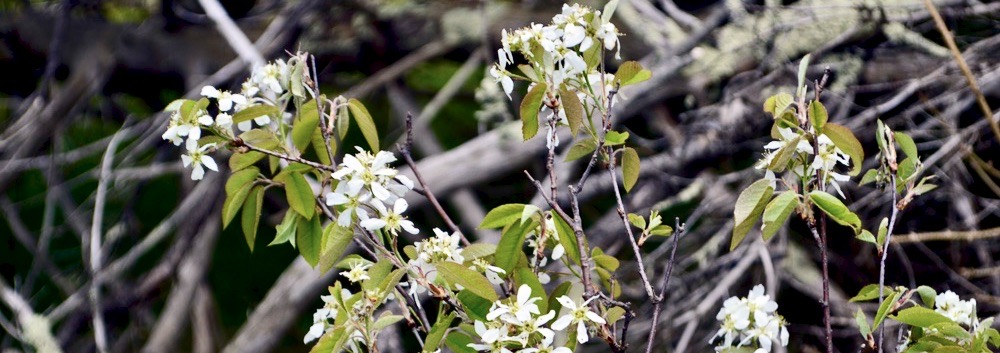
Invasive Plant Species
Invasive Plant Management
Active management of invasive plant species to promote the regrowth of native plant species is a goal of the Oceanside Conservation Land Trust of Casco Bay.
What are invasive plants?
Invasives, such as Japanese honeysuckle and Oriental bittersweet, are plant species that are not native to our region, usually transported by humans, and that thrive in their new environment to the detriment of native species.When invasive species dominate a landscape they compete with the native plants, which provide high value food and nesting habitat for birds and other animals.Invasive plants can be spread by wildlife or by human activities or escape from decorative garden plantings. Since many invasive plants require direct sunlight, they often thrive along forest edges and where local environments have been disturbed.Invasive plant species often lack natural predators, diseases, and other pathogens that keep them in check in their native habitats. They have competitive adaptations including early leaf-out, aggressive reproductive strategies, and efficient dispersal methods.
What’s wrong with Invasives?
By out-competing our native plants, invasives starve the ecosystem of its natural carrying capacity. It takes wildlife an extremely long time to evolve the ability to consume invasive plants. Foreign introductions are undesirable or indigestible to our native animals so the food web is robbed of essential nutrients.
What techniques should be used to control invasive plants?
As much as possible, the work should be achieved using manual labor and hand tools or mechanical mowing. Approaches such as pulling and digging are best employed in the spring when the soil is moist and seeds have not yet formed. Mid August thru October is a good time to cut invasives as the plants are drawing energy into their roots for Spring growth. Cutting or mowing can prevent plants from photosynthesizing, but may need to be continued for 3 to 5 years before complete eradication. Plant removal in the shore land zone may require permitting or must be done according to state rules or local ordinances.
Pesticides
In order to insure that some species do not return stronger than before, a targeted application of an herbicide, which is fast acting and breaks down quickly may be employed, directly on the invasive species only. Pesticide application should be carried out by a licensed applicator. The most commonly used pesticides are Glyphosate (found in Roundup or Rodeo for wetland areas) and Tric10pyr (found in Brush-Be-Gone, Garlon or Renovate). Use of herbicides can be limited by using the cut-stem approach, in which the stem of a plant is cut and herbicide applied to the cambium layer of the freshly cut surface. This procedure requires less herbicide than overall spraying of foliage. Potential effects of chemicals on non-target species (such as invertebrates, amphibians, and native plants) should be considered before any application. Chemical treatments, while often effective, can be costly.
Understanding Pesticide Rules
The common herbicides used to control invasive plants are regulated as pesticides. A commercial pesticide applicator license is required to legally apply an herbicide when the application will take place in an area open to the public, The affected part of the property should be clearly posted as closed to public use for seven daysfollowing the application.
Only licensed applicators may purchase and apply aquatic herbicides like Rodeo or Renovate or "restricted use" pesticides like Tordon. For more information on control options, visit www.thinkfirstspraylast.org or contact Gary Fish at the Maine Board of Pesticides Control (gary.fish@maine.gov, 207 287-2731).
Why should you care?
Invasive species are the second-greatest threat to global biodiversity after loss of habitat. Invasive plants are a direct threat to what we value about Maine's natural and working landscapes. Their aggressive growth threatens our recreational experiences. Invasive plants can choke waterways, form thorny, impenetrable thickets in forests impacting recreational use.
What can you do?
Verify that plants you buy for your yard or garden are not invasive. Ask your local garden supplier to include more native species. Replace invasive plants in your garden with non-invasive alternatives. When boating, clean your boat thoroughly before transporting it to a different body of water. Volunteer at your local park, refuge, or other wildlife area to help remove invasive species. Help educate others about the problem.
Link to University of Maine Coopertive Extension Service - Conserving Maine's Native Landscape
Invasive Publications
Winning the War on Weeds by Bob Bittenbender and Amanda Devine of Casco Bay Invasive Species Network. Printed editions available at Longfellow Books in Portland, ME.
Invasive Plants on Cliff Island Part 1
Invasive Plants on Cliff Island Part 2
Invasive Plants on Cliff Island Part 3
Changing the Law on the Sales of Invasives - Tom Atwell, Portland Press Herald
Invasive Plant Species List
Common name (Scientific name)
Black Swallowwort (Cynanchum louiseae)
Multiflora or Rambler Rose (Rosa multflora)
Rugosa Rose (Rosa rugosa) - considered invasive in coastal habitats by MNAP
Common Buckthorn (Rhamnus cathartica)
Common Reed (Phragmites australis) - non-native type only
Purple Loosestrife (Lythrum salicaria)
Tartarian Honeysuckle (Lonicera tartarica)
Morrow Honeysuckle (Lonicera morrowii)
Glossy Buckthorn (Frangula alnus)
Japanese Knotweed (Fallopia japonica) - also known as Mexican Bamboo
Autumn Olive (Eleagnus umbellata)
Russian Olive (Eleagnus angustifolia)
Asiatic Bittersweet (Celastrus orbiculata)
Japanese Barberry (Berberis thunbergii)
Garlic Mustard (Alliari petiolata)
Norway Maple (Acer platanoides)
Rules prohibting the sale and distribution of 33 plants that have been deemed invasive in Maine
